人教版七年级下册Unit 4 Don't eat in class. Section A 2a -2d课件(共19张PPT,无音频)
文档属性
| 名称 | 人教版七年级下册Unit 4 Don't eat in class. Section A 2a -2d课件(共19张PPT,无音频) |  | |
| 格式 | zip | ||
| 文件大小 | 2.9MB | ||
| 资源类型 | 教案 | ||
| 版本资源 | 人教新目标(Go for it)版 | ||
| 科目 | 英语 | ||
| 更新时间 | 2023-02-03 22:04:59 | ||
图片预览

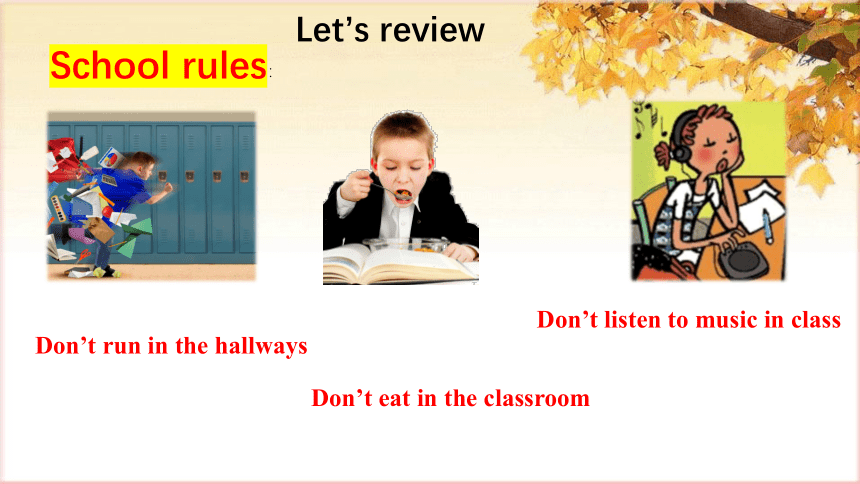
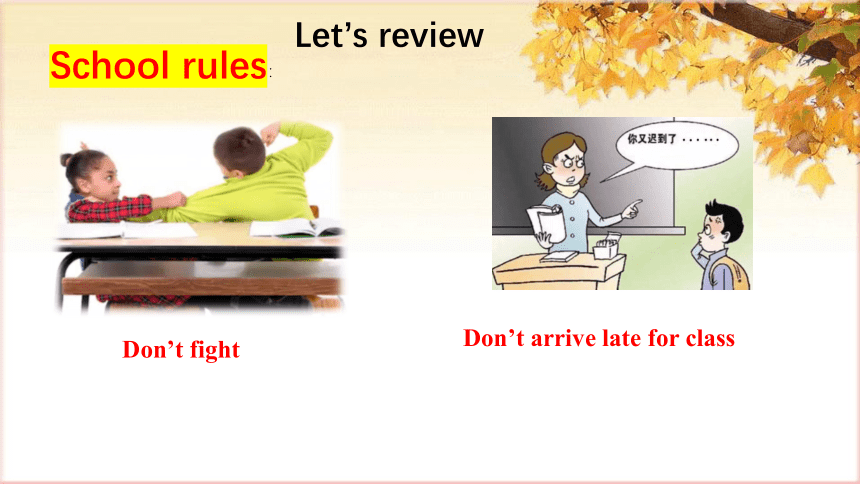

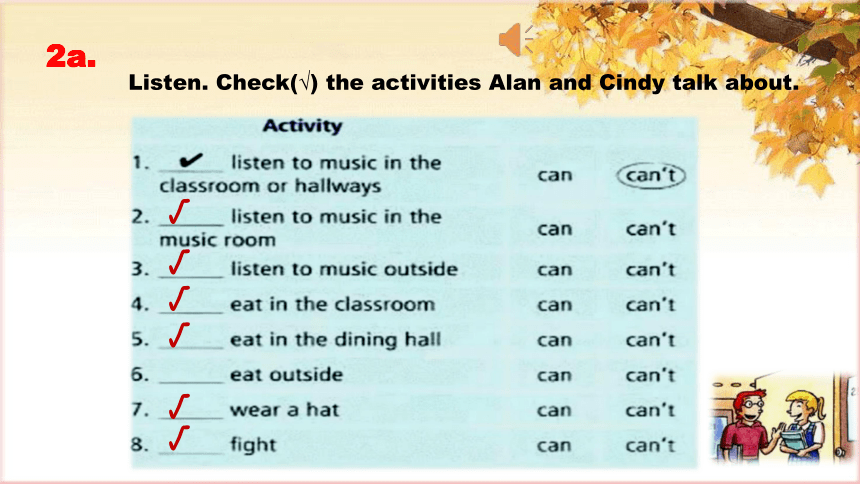
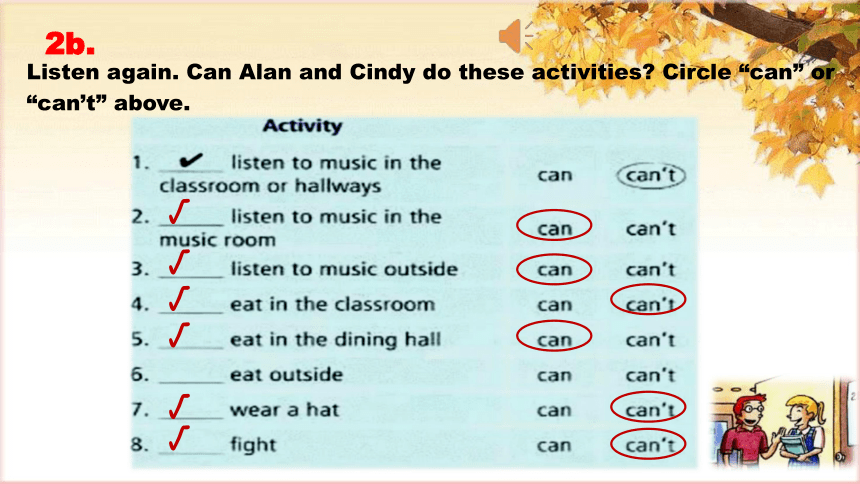
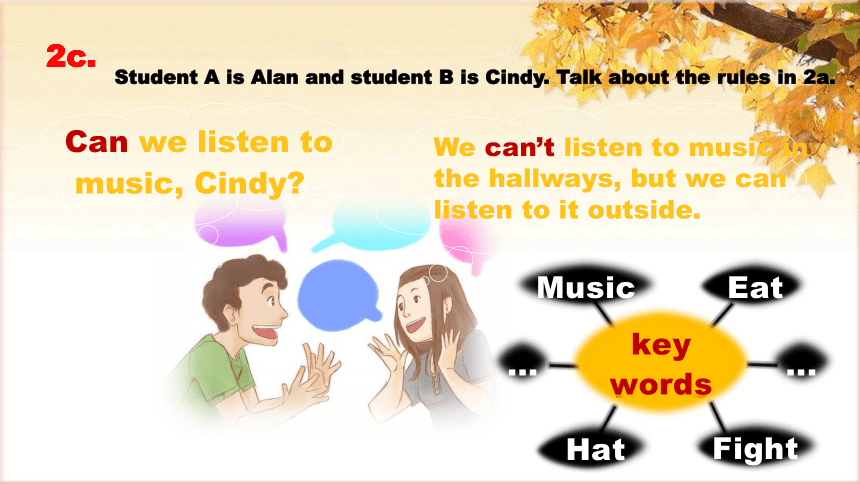
文档简介
(共19张PPT)
Unit 4
Don’t eat in class.
Section A 2a-2d
Don’t run in the hallways
Don’t eat in the classroom
Don’t listen to music in class
School rules:
Let’s review
Don’t fight
Don’t arrive late for class
School rules:
Let’s review
Predict
2a.
Look at the picture
Who are they
What are they talking about
Listen. Check(√) the activities Alan and Cindy talk about.
√
√
√
√
√
√
2a.
Listen again. Can Alan and Cindy do these activities Circle “can” or “can’t” above.
√
√
√
√
√
√
2b.
Student A is Alan and student B is Cindy. Talk about the rules in 2a.
Can we listen to
music, Cindy
We can’t listen to music in
the hallways, but we can
listen to it outside.
...
...
School Rules
Music
Eat
Hat
Fight
key words
2c.
2d.
Look at the picture:
A new student---John comes to our school,what school rules will we tell him
Jhon
Read the conversation and fill in the chart.
DONs DOs
be late for class
bring music players to school
be on time
wear the school uniform
be quiet in the library
2d.
Listen and then read aloud
2d.
1. wear a hat 戴帽子
wear v. 穿;戴
The girl often wears a red coat and a white hat.
这个女孩经常穿着红色的上衣戴着白色的帽子。
Language points
wear强调“穿着”这一状态,也可表示“戴着”。如:
She likes wearing colorful clothes. 她喜欢穿着颜色鲜艳的衣服。
dress既可表示动作,又可表示状态,常由人作宾语,意为“给……穿衣服”。如:Could you dress the child for me 你能不能替我给小孩穿上衣服
wear, dress 与 put on的区别
当表示自己穿衣服时,一般用“get dressed (= dress oneself)”. 如:
He cannot get dressed( = himself).他不会自己穿衣服。
当dress表示状态时,一般要用“be dressed in”的形式。如:
She is dressed in a red coat. 她穿着一件红色的上衣。
put on着重于“穿”这一动作,即由没穿到穿这一过程的完成,意为“穿上”。如:
Please put on your new coat.
请穿上你的新大衣。
用 wear, put on, dress 的适当形式填空。
She is _________ a red flower in her hair.
2. He ________ his coat and goes out.
3. He is _________ black.
wearing
puts on
dressed in
2. Can we bring music players to school
我们能把音乐播放机带到学校来吗?
bring v. 带来;取来
Can you bring me an English dictionary
你能给我带来一本英语字典吗?
bring 与 take 的区别
Bring your homework here, and take the book away.
把你的作业拿过来,把这本书带走。
bring 指往里带,而take 则指往外带。
---Why do Chinese people like red
---Because they think it can ____ them good luck.
A. carry B. bring C. make D. take
B
3.祈使句补充
1). Be+表语
如:Be quick!快一点!
2). Let +宾语+动词原形+其他成分。
注:let后面的宾语是第一人称的时候,否定形式是在宾语后面加not。
如:Let’s not do that again.
如果let的后面宾语是第三人称的时候,否定形式是在
let前加助动词don’t
如:Don’t let them come in.
情态动词
can
1. 表示能力:“会,可以,能,能够”
2. 不能单独作谓语,后必须接动词原形一起构成谓语
3. 没有人称的数的变化
4. 否定形式加not: can not,cannot, 或缩写can't疑问句can 提前。
例: I can't play the gutar.
Can we eat in the classroom
Thank you
Unit 4
Don’t eat in class.
Section A 2a-2d
Don’t run in the hallways
Don’t eat in the classroom
Don’t listen to music in class
School rules:
Let’s review
Don’t fight
Don’t arrive late for class
School rules:
Let’s review
Predict
2a.
Look at the picture
Who are they
What are they talking about
Listen. Check(√) the activities Alan and Cindy talk about.
√
√
√
√
√
√
2a.
Listen again. Can Alan and Cindy do these activities Circle “can” or “can’t” above.
√
√
√
√
√
√
2b.
Student A is Alan and student B is Cindy. Talk about the rules in 2a.
Can we listen to
music, Cindy
We can’t listen to music in
the hallways, but we can
listen to it outside.
...
...
School Rules
Music
Eat
Hat
Fight
key words
2c.
2d.
Look at the picture:
A new student---John comes to our school,what school rules will we tell him
Jhon
Read the conversation and fill in the chart.
DONs DOs
be late for class
bring music players to school
be on time
wear the school uniform
be quiet in the library
2d.
Listen and then read aloud
2d.
1. wear a hat 戴帽子
wear v. 穿;戴
The girl often wears a red coat and a white hat.
这个女孩经常穿着红色的上衣戴着白色的帽子。
Language points
wear强调“穿着”这一状态,也可表示“戴着”。如:
She likes wearing colorful clothes. 她喜欢穿着颜色鲜艳的衣服。
dress既可表示动作,又可表示状态,常由人作宾语,意为“给……穿衣服”。如:Could you dress the child for me 你能不能替我给小孩穿上衣服
wear, dress 与 put on的区别
当表示自己穿衣服时,一般用“get dressed (= dress oneself)”. 如:
He cannot get dressed( = himself).他不会自己穿衣服。
当dress表示状态时,一般要用“be dressed in”的形式。如:
She is dressed in a red coat. 她穿着一件红色的上衣。
put on着重于“穿”这一动作,即由没穿到穿这一过程的完成,意为“穿上”。如:
Please put on your new coat.
请穿上你的新大衣。
用 wear, put on, dress 的适当形式填空。
She is _________ a red flower in her hair.
2. He ________ his coat and goes out.
3. He is _________ black.
wearing
puts on
dressed in
2. Can we bring music players to school
我们能把音乐播放机带到学校来吗?
bring v. 带来;取来
Can you bring me an English dictionary
你能给我带来一本英语字典吗?
bring 与 take 的区别
Bring your homework here, and take the book away.
把你的作业拿过来,把这本书带走。
bring 指往里带,而take 则指往外带。
---Why do Chinese people like red
---Because they think it can ____ them good luck.
A. carry B. bring C. make D. take
B
3.祈使句补充
1). Be+表语
如:Be quick!快一点!
2). Let +宾语+动词原形+其他成分。
注:let后面的宾语是第一人称的时候,否定形式是在宾语后面加not。
如:Let’s not do that again.
如果let的后面宾语是第三人称的时候,否定形式是在
let前加助动词don’t
如:Don’t let them come in.
情态动词
can
1. 表示能力:“会,可以,能,能够”
2. 不能单独作谓语,后必须接动词原形一起构成谓语
3. 没有人称的数的变化
4. 否定形式加not: can not,cannot, 或缩写can't疑问句can 提前。
例: I can't play the gutar.
Can we eat in the classroom
Thank you
同课章节目录
- Unit 1 Can you play the guitar?
- Section A
- Section B
- Unit 2 What time do you go to school?
- Section A
- Section B
- Unit 3 How do you get to school?
- Section A
- Section B
- Unit 4 Don't eat in class.
- Section A
- Section B
- Unit 5 Why do you like pandas?
- Section A
- Section B
- Unit 6 I'm watching TV.
- Section A
- Section B
- Review of Units 1-6
- Unit 7 It's raining!
- Section A
- Section B
- Unit 8 Is there a post office near here?
- Section A
- Section B
- Unit 9 What does he look like?
- Section A
- Section B
- Unit 10 I'd like some noodles.
- Section A
- Section B
- Unit 11 How was your school trip?
- Section A
- Section B
- Unit 12 What did you do last weekend?
- Section A
- Section B
